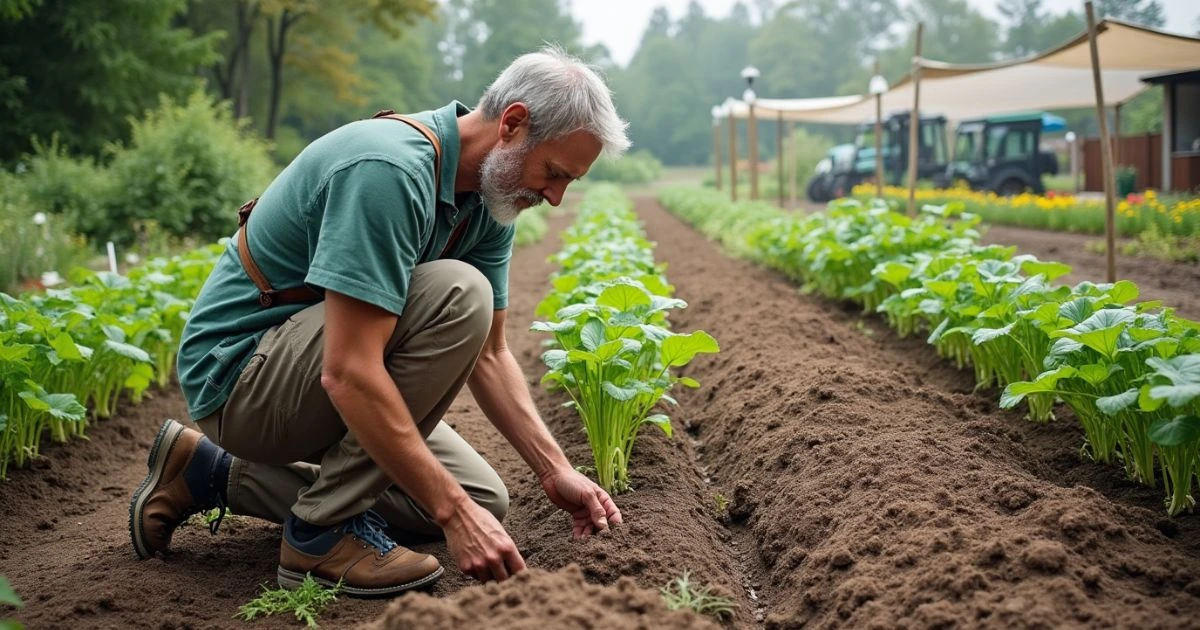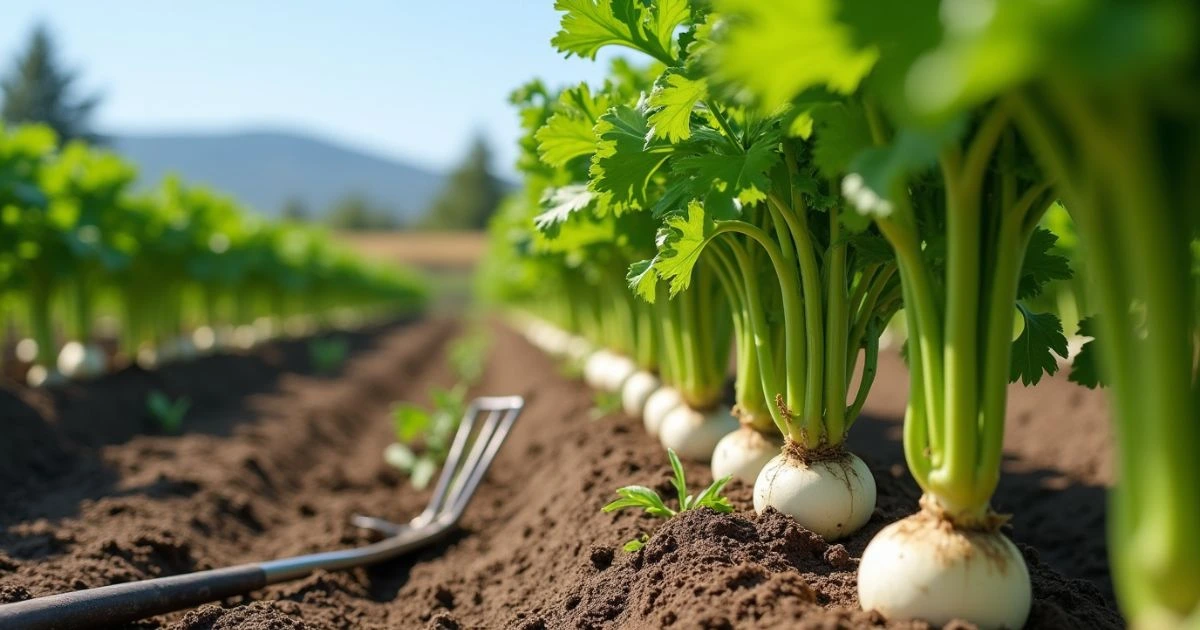Growing daikon radish can be a deeply satisfying endeavor, offering fresh, flavorful roots perfect for your kitchen. By following a few straightforward techniques, you can ensure a bountiful harvest that meets your expectations. Let’s dive into five essential tips for growing daikon radish successfully.
Table of Contents
Why Growing Daikon Radish is Rewarding
Daikon radish is not just another root vegetable. Its crisp texture, mild flavor, and versatility make it a favorite for salads, pickles, and soups. Moreover, it’s a fast-growing crop that fits into almost any gardening schedule. Whether you’re a novice gardener or an experienced green thumb, daikon radish offers plenty of rewards for your efforts. Beyond its culinary uses, daikon radish is also beneficial for soil health, often used as a cover crop to improve soil structure and suppress weeds. Additionally, it has natural pest-repelling properties, making it a valuable companion plant in your garden.
Choosing the Right Variety of Daikon Radish
Why Variety Matters

When growing daikon radish, selecting the right variety can make or break your harvest. Different types thrive in specific climates and serve unique culinary purposes. Popular varieties include:
- Minowase: Ideal for cool climates with large, sweet roots.
- Watermelon: Known for its vibrant pink interior and slightly spicy taste.
- KN-Bravo: A standout for its purple skin and earthy flavor.
How to Choose Your Variety
- Climate Compatibility: If you live in a warm region, opt for heat-resistant types like ‘April Cross.’ For cooler climates, ‘Minowase’ is a reliable choice.
- Purpose: Choose mild-flavored varieties for fresh eating or stronger ones like ‘Shunkyo’ for pickling.
| Variety | Best Climate | Flavor Profile | Unique Features |
| Minowase | Cool climates | Sweet, crisp | Large roots |
| Watermelon | Moderate climates | Mild, colorful | Vibrant pink interior |
| KN-Bravo | Mild climates | Earthy, slightly sweet | Purple exterior |
Selecting the right variety ensures that your daikon radishes thrive in your local environment while meeting your culinary needs.
Preparing the Soil for Success
Soil Requirements

Daikon radish thrives in loose, loamy soil with good drainage. Compacted or rocky soil can lead to misshapen roots, so proper preparation is critical.
Steps to Prepare Your Soil
- Test Soil pH: Aim for a pH between 5.8 and 6.8.
- Remove Debris: Clear rocks and weeds to allow roots to grow unobstructed.
- Enrich the Soil: Add organic compost to improve fertility and structure.
- Deep Tilling: Loosen the soil to a depth of 12-15 inches to accommodate the long roots of daikon radish.
- Incorporate Organic Matter: Mix in aged manure or green compost to enhance soil health and nutrient availability.
- Mulching: Apply a thin layer of mulch to protect the soil from erosion and retain moisture during planting.
By giving attention to soil preparation, you’ll create the ideal environment for robust root growth. Consider using green manure or cover crops like clover before planting to enhance soil health further.
Timing: When to Plant Daikon Radish

Planting daikon radish at the right time is vital for healthy growth. This crop prefers cooler temperatures, so it’s best to sow seeds in late summer or early fall. Proper timing not only boosts growth but also prevents premature bolting.
Key Planting Windows
- Late Summer: Sow seeds in August for fall harvests.
- Early Fall: Plant in September for a winter yield.
- Winter: In mild climates, sow seeds as late as November.
| Season | Planting Period | Care Instructions |
| Late Summer | August-September | Maintain soil moisture |
| Early Fall | September-October | Thin seedlings |
| Winter | November-December | Monitor for frost damage |
Managing Seasonal Challenges
- In warmer climates: Use shade cloth to protect seedlings from intense heat.
- In colder climates: Mulch heavily to insulate the soil and prevent frost damage.
Planting Techniques: How to Grow Daikon Radish
Step-by-Step Planting Guide

- Prepare the Garden Bed:
- Aerate the soil to a depth of 12–15 inches.
- Incorporate compost or well-aged manure to enhance soil fertility.
- Mark Rows:
- Space rows 12-18 inches apart to ensure good airflow.
- Use a string or stakes to keep rows straight.
- Sow Seeds:
- Plant seeds ½ inch deep.
- Space seeds 4-6 inches apart for optimal root development.
- Water Thoroughly:
- Moisten the soil immediately after planting.
- Maintain consistently moist soil until the seedlings sprout.
- Thin Seedlings:
- Once seedlings reach 2 inches tall, thin them to one plant every 6 inches.
- Use scissors to cut extra seedlings rather than pulling them out to avoid root disturbance.
- Apply Mulch:
- Spread a light layer of organic mulch to retain moisture and suppress weeds.
- Add Support:
- For larger varieties like ‘Minowase,’ consider using soil mounds or ridges to support the roots and keep them straight.
Following these steps ensures healthy, straight roots and minimizes competition among plants.
Watering and Feeding: Essential Care Tips
Watering Basics

Keep the soil evenly moist without waterlogging. Applying mulch helps conserve moisture and maintain consistent soil temperature.
Fertilization Tips
- Start Strong: Use a balanced fertilizer like 10-10-10 during early growth stages.
- Mid-Season Boost: Apply compost tea or side-dress with organic matter halfway through the growing period.
- Avoid Excess Nitrogen: Too much nitrogen encourages leafy growth at the expense of the roots.
For best results, focus on phosphorus and potassium, which promote root development and strengthen the plants against stress. Regularly inspect plants for signs of nutrient deficiencies, such as yellowing leaves, and address them promptly.
Managing Pests and Diseases
Common Problems

Daikon radish can fall prey to pests and diseases, such as:
- Flea Beetles: Leave tiny holes in leaves.
- Aphids: Cluster on stems and leaves.
- Root Rot: Caused by overly wet soil.
Solutions
- Prevention: Use row covers to protect plants from pests.
- Natural Remedies: Spray neem oil or introduce ladybugs to control aphids.
- Crop Rotation: Avoid planting daikon in the same spot every year to reduce disease risk.
| Issue | Symptoms | Remedy |
| Flea Beetles | Holes in leaves | Use floating row covers |
| Root Rot | Soft, discolored roots | Improve soil drainage |
Additionally, interplanting daikon radish with pest-repelling herbs like basil or marigold can help deter unwanted insects naturally.
Harvesting and Storing Your Daikon Radish
When to Harvest

Harvest daikon radish when roots are 6-20 inches long, depending on the variety. The tops of the roots should slightly protrude from the soil. For best flavor, avoid letting the roots over-mature.
Harvesting Tips
- Use a garden fork or spade to gently loosen the soil around the roots.
- Pull the radish straight up to avoid breaking the roots.
- Harvest early in the morning when the soil is cool and moist.
Storing Techniques
- Short-Term Storage: Keep radishes in a cool, dark place for up to two weeks.
- Long-Term Storage: Pickle or freeze them for extended use.
For added freshness, store radishes with their greens removed to reduce moisture loss.
Daikon Radish Flowers: What to Know
Daikon radish flowers are a sign of bolting, often caused by heat stress or late planting. However, these flowers are edible and make a beautiful garnish for salads and dishes. If your plants bolt, allow some flowers to go to seed for future planting. Additionally, the seeds can be used for microgreens, which are packed with nutrients.
FAQs About Growing Daikon Radish
1. What is the best time to plant daikon radish?
Plant in late summer or early fall for best results.
2. How deep should daikon radish seeds be planted?
Sow seeds approximately ½ inch deep in properly prepared soil.
3. Can daikon radish grow in containers?
Yes, as long as the container has a minimum depth of 12 inches.
4. Why are my radishes flowering?
This occurs when the plant bolts due to stress from heat or drought.
5. How long does daikon radish take to grow?
Most varieties mature in 50-70 days.
6. What health benefits does eating daikon radish offer?
Daikon is packed with vitamins C and B6, potassium, and fiber, promoting digestion and strengthening immunity.
7. How do you store daikon radish seeds?
Keep seeds in a cool, dry location to preserve their viability.
8. Are daikon radish flowers edible?
Yes, the flowers are edible and make a beautiful garnish.
9. How can I improve soil for daikon radish?
Incorporate organic compost and test soil pH regularly.
10. How do I protect daikon from pests?
Use row covers and natural insect repellents like neem oil.
Conclusion
Growing daikon radish is a rewarding journey that brings fresh, healthy produce to your table. By following these expert tips on timing, planting, care, and harvesting, you can achieve a thriving crop. Start your gardening adventure today and enjoy the satisfaction of cultivating this versatile root vegetable.
Ready to transform your garden? Share your growing daikon radish success stories or questions in the comments below! Be sure to subscribe to our newsletter for more gardening tips and advice.


